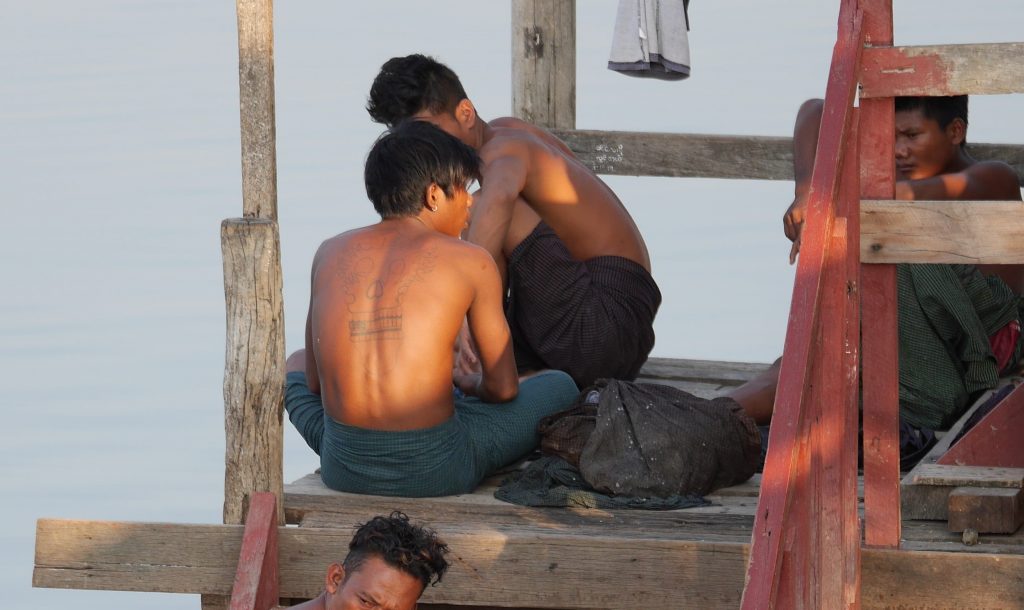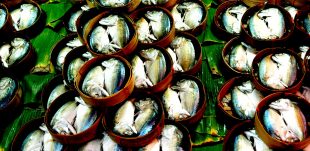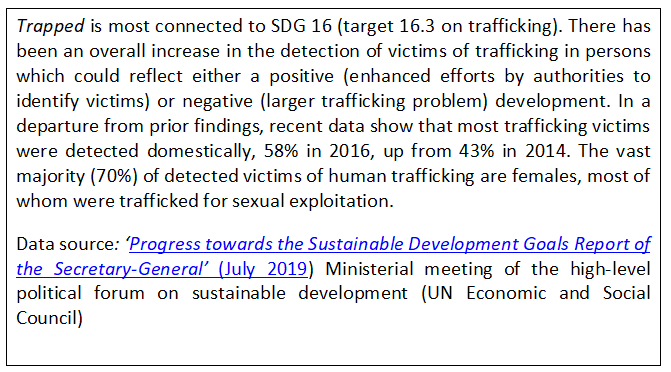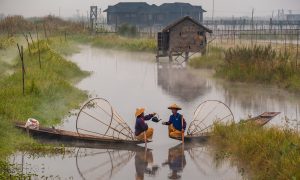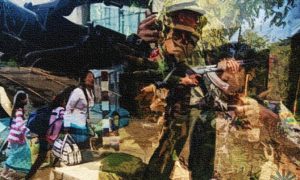Slavery or, to give it its modern name, forced labour or indentured labour—is something you probably associated with bygone eras. Sadly, it is very much a modern 21st-century problem. It is also often right in front of your eyes. From fishing boats off the Andaman Sea trawling for shrimp that ends up in products on shelves in supermarkets, through to agricultural workers in southern California picking oranges to labourers on trawlers in the Irish Sea, the practice is pervasive and the numbers are huge. An estimated 40 million people are victims of modern slavery and for forced labour specifically, the prevalence is highest in Asia and the Pacific, where four out of every 1,000 people were victims.
Slavery and forced labour are to be found in construction sites, mines, domestic workers in people’s homes, agriculture and fishing, and the sex industry. Men are found more in agriculture and construction sectors while women tend to end up in the sex industry and as domestic workers. Nearly 4 million adults were victims of forced sexual exploitation and 1 million children were victims of commercial sexual exploitation. The vast majority of victims (99%) were women and girls. More than seven in ten victims were exploited in the Asia and the Pacific region.
One in four victims of modern slavery is a child.
The reason slavery is still so widespread is because it is big business. Modern slavery and trafficking is now the second-largest criminal industry in the world, with estimated annual profits from forced labour at $150 (USD) billion per year. That’s about half the entire GDP of Malaysia. Two-thirds of this estimated total, $99 (USD) billion, came from commercial sexual exploitation, while another $51 (USD) billion resulted from forced economic exploitation, including domestic work, agriculture and other economic activities. On top of this, $34 (USD) billion came from construction, manufacturing, mining and utilities; $9 (USD) billion from agriculture, including forestry and fishing; and $8 (USD) billion from private households not paying or underpaying domestic workers held in forced labour.
For the most part modern slavery is found in the private sector, but a sizable chunk is state-based. A little over four million people (on average) were in state-imposed forced-labour situations in 2016. These included forcing people to work on state-run agriculture or construction projects and young military conscripts.
Between the years 2011 and 2016, nearly 90 million people experienced some form of modern slavery for periods of time ranging from a few days up to a full five years. These workers are providing services or making products that often end up in legitimate commercial channels. They produce some of the food we eat and the clothes we wear, and they have cleaned the buildings in which many of us live or work.
Do not adjust your watch, it is still 2020.
State and military slavery in Myanmar
“You guys call yourself an army, you look more like babysitters to me.” These were the words the Director of the ILO’s Myanmar office, Steve Marshall, spat out at a confrontational meeting with the Tatmadaw, as the Myanmar military are known. [Ed. The author is co-chair of the ILO/GiZ Development group on private sector development in Fragile States.]
The military government in Myanmar at the time (2008) had committed to ending the widespread practice of slavery in the country, which was particularly present in the military. Steve’s irate reaction was in response to a case of several soldiers who had gone AWOL and had been rounded up and incarcerated, awaiting a military tribunal. What actually had happened, Steve told me, was that the AWOLs were a group of 14-year-old boys who had ran off home. “They wanted to be with their mothers,” he told me.
The military junta, which seized power in Myanmar in 1962, had a long reputation of using slavery for state infrastructure projects, such as the building of roads, bridges, military bases or even towns. The military typically demanded workers from local villages, with the threat of fines if households were unable to supply the required amount of people. This task was made much easier by the existence of registration documents which detailed the exact number of inhabitants, property and livestock within any given village.
Projects varied in length and intensity, but they always meant that people were taken away from their land and livelihoods without any remuneration in return. Officers in charge of projects were often under pressure to meet demands for projects to be finished. This resulted in an often exceedingly harsh environment. Threats, harassment, beatings and even killings were not uncommon, and women risked rape and other sexual abuses. One particularly brutal example was the use of villagers as human minesweepers to clear the way for the safe passage of soldiers. On top of that, as villagers were unable to work on their own agricultural work for days or even weeks on end, their own livelihoods suffered.
The Tatmadaw also had its own particular needs—recruits! The military needed a steady stream of conscripts and boys as young as 12 were recruited to fight against ethnic-minority rebels. The children were often kidnapped while on their way home from school then shipped off to fight in the country’s many civil wars.
The International Labour Organisation at work
The ILO’s work into Myanmar today consists of programmes on a wide range of topics from youth employment, social protection, skills development, to supporting peace efforts in Rakine and Karen States. But initially its work was just focused on forced labour/slavery.
The reason the ILO was allowed in Myanmar was because the country had ratified the International Labour Standard or Convention concerning the Abolition of Forced Labour (Convention № 29) in 1955. A Convention is an international treaty with obligations. Myanmar was on the hook.
In 1996, during the International Labour Conference, 25 delegates filed a complaint against the Government of Myanmar for violating its obligations under this Convention. Soon after, the Governing Body of the ILO appointed a Commission of Inquiry.
After a series of attempts to persuade the Myanmar government to comply with the recommendations of the Commission, a resolution calling on all ILO members to review their contacts with Myanmar so as not to aid the government in their violations of the Forced Labour Convention, was adopted in 2000. As a result of this resolution and the wider campaign for sanctions, several governments imposed trade sanctions on Myanmar.
Increased awareness of forced labour and human rights abuses in Myanmar was also being amplified. An international campaign was having good affect. “Triumph: support breasts not dictators” was a brilliant tag line by a British NGO to badger the lingerie company Triumph about its operations in Myanmar in the early 2000s. Their initial and slightly funnier banner ‘Support Genitals—Not Generals’ unfortunately never got used. Triumph succumbed to the pressure and eventually pulled out. All of this was raising the pressure on an isolated government.
The complaint against the Government of Myanmar developed into a substantive case that became a standing agenda item on the ILO’s Governing Body. The Ambassador of Myanmar was called in to each session to outline progress. By the early 2000s it was clear that the Government of Myanmar wanted to open up. Maybe the sanctions and other measures in place were beginning to have an impact or maybe the generals were tired of their isolation. Either way a ‘glasnost’ of sorts emerged.
This paved the way for the ILO to establish a ‘Liaison Office’ to monitor the progress (or not) of the Government’s efforts to end forced labour/slavery. The Liaison Office was initially opened in 2002 but in 2007 it was given a wider and more powerful brief under Steve Marshall, a chain-smoking former police officer from New Zealand, and his deputy Piyamal Pichaiwongse, who moved up from the ILO’s regional office in Bangkok. Their brief was to document any claims of forced labour. A watchtower of sorts.
The agreement between the ILO and the Myanmar government also specifically allowed ‘Myanmar Resident Citizens’ the right to lodge complaints alleging the use of forced labour/slavery. This complaints mechanism was designed to allow genuine victims of forced labour, with the assistance of the ILO Liaison Officer, an opportunity to seek redress and/or remedies from the government authorities in full confidence that no retaliatory action would be taken against them.
Steve and Piyamal ran the Office out of the Traders Hotel (now the Shangri La) in Yangon. I remember going to see Steve on my first visit to Yangon in 2012. Truly a bizarre experience. You enter the lobby of an international hotel, much like anywhere. Make your way to the elevator. Head right and eventually you get to the ‘ILO Office’—two hotel rooms on the fifth floor.
As I chatted to Steve in his office on that first visit, the cackle from the next room became more and more heated. I followed Steve in and found a desperately upset middle-aged woman clutching a photo and a sheet of crumbled papers in animated discussion with Ron, the ILO driver cum office all-rounder. Ron calmed the woman down and they got back to what seemed like a form being filled in.
I asked Steve what was going on. He explained that officially the ILO office served to document complaints about forced labour/slavery. Unofficially what was happening was that word filtered out that this was a place that any kind of complaints on any human rights abuses could be lodged. Word travelled fast and on that wet Wednesday morning the line of (mostly women) went all the way to the elevator.
All kinds of terrible cases were gathered.
One story Steve told me was of a mother who had been dismissed from her government job. She was a single mother and her teenage son had committed some indiscretion at university. The son was a Grade A student and great things were expected of him. So the mother was called in and it was explained to her that, as the son had much potential and the country needed educated individuals like him in top government jobs, they would not expel him. However, his indiscretion still needed to be punished. So she was informed that she would be sacked from her job as a way to balance things up. There was lots of stuff like this.
Towards an end to slavery
The ILO did not end slavery or forced labour in Myanmar. It still continues. There is still a big ILO programme on forced labour in Myanmar today and the Forced Labour Complaints Mechanism is still in operation. However, the ILO programme (and the advocacy work around it) helped shine a spotlight on this nasty practice.
It also created more awareness across the South Asia Region, a region with a long history of the practice.
The struggles and abuses experienced by both Thai and migrant workers in Thailand’s US$7 (USD)billion fishing and seafood industry were reported in graphic detail around the world. That uncomfortable spotlight resulted in pressure from rights groups, NGOs, consumers and Brands for demonstrable action.
One consequence of that pressure was the ILO’s programme aimed at eradicating slavery in the fishing sector in the Andaman Sea. It has been slow going but solid progress has been made.
According to the ILO’s Country Director for Thailand, Graeme Buckley:
“You can criticize it, and it has been, but our way is slow and steady engagement. This means working with all the stakeholders, frustrating as that can be. The fishing-boat owners, Thai government and Thai navy, the sectorial associations representing the industry, the big local companies and the international big brands (who will have often competing interests to the local business actors) as well as the unions, and rights groups. This is not always good enough for everybody but definitely is effective and I think our results are showing that.”
That slow meticulous approach has arguably delivered. An ILO study of the fishing and seafood processing sectors (2018) which involved interviews with 434 workers demonstrated that progress. There were fewer reports of physical violence; less reports of workers (less than 1%) under 18 years old; 43% of fishers reported having written contracts (a significant increase from four years previously); and higher average real monthly wages (before deductions) for some fishers.
Persistent challenges were also highlighted: 34% of workers reported being paid less than the minimum wage (before deductions); a wide gender pay gap with 52% of women reporting pay below the legal minimum; 24% of fishers saw their pay withheld by vessel owners, some for 12 or more months, and 34% reportedly did not have access to their identity documents.
Significantly—and in no short measure due to the spotlight and pressure of the ILO programmatic work—in 2018 Thailand ratified the ILO’s Protocol of the Forced Labour Convention (P29)—the first in Asia. This marked an important shift and is pushing the pace of policy and behavioural change.
The decision to ratify the Convention was designed to send a signal that Thailand was getting serious about cleaning up the persistent issue of slavery and forced labour in its fishing sector.
Legislative and policy changes such as the “Thai Anti-Trafficking Act” are now translating into better outcomes on the boats. According to Chith Jed Poth—who was just 17 when he migrated from Cambodia to work in the Thai fishing industry in 2007, “There has been a great improvement, especially with the pay being more consistent and much higher. The workload is now better scheduled and we have more rest time.”
However, challenges remain, especially in making changes to employer practices, and to Thai government rules and the effective enforcement of the new rules. One of the key issues is reliable data in particular around how inspections have/haven’t produced much in terms of enforcement. There’s plenty of cheating in fishing—catch and labour—so the playing field is uneven between companies and between ports/regions.
Yet there is a sense of a momentum shift.
The message that respect for the fundamental rights of workers—both Thai and migrant—is not just about basic human rights and complying with Thai law, it is also about business and competitiveness. This has started to resonate with Thai Policy makers and across the industry. In addition, buyers of Thai seafood around the world now are increasingly concerned about reputational damage from claims of slavery in their supply chains. Without fundamental changes, they will look elsewhere for product.
Global efforts
Today, while there is a long way to go, there are a number of reasons to be hopeful that this invidious practice is on the back foot.
First of all, things are changing on the legislative front. The US State of California was the initial pioneer and in 2010 it enacted The California Transparency in Supply Chains Act. The law requires large retail and manufacturing companies doing business in the state of California bringing in more than $100 million in annual gross receipts to disclose their efforts to eradicate slavery and human trafficking from their supply chains. Major brands such as Costco, Nestlé, Mars and Hershey have been on the wrong side of lawsuits driven by this legislation.
The UK introduced legislation in 2015—the Modern Slavery Act—on the prevention and prosecution of modern slavery and the protection of victims. This legislation makes companies accountable for slavery and labour abuses occurring along their whole chain of operations and it has a range of provisions to increase transparency in supply chains. Today, any UK business—or a part of that business—that has a global turnover of $47 (USD) million or more and supplies goods or services in the UK has to produce and publish a public annual slavery and trafficking statement every year. The statement must set out what steps the company has taken to ensure there is no slavery in any part of its business, including all its supply chains. Former British prime minister Theresa May said at the ILO’s International Labour Conference in 2019 that this legislation was one of her proudest achievements while in politics.
Australia adopted similar legislation—the Modern Slavery Act—in 2019 while the French National Assembly adopted the Duty of Vigilance Law in 2017. Similar legislative efforts have been proposed in Hong Kong, the European Union, The Netherlands and Switzerland.
Second, the availability of information and the impact it can have on companies’ reputations are having positive effects. The fact is that companies today are now much more concerned about their own actions and the actions of their suppliers and where their supplies come from. The stakes are high. One bad headline can have a devastating impact on a brand. They are much more proactive on this stuff.
Third, old-fashioned investigative journalism is making a difference. The youthful appearance and easy manner and charm of Esther Ntusan from Kachin State in the north of Myanmar and the wife of my Yangon based colleague Jared Bissenger can easily deceive. She is not yet 30 but already has a Pulitzer Prize to her name. She was part of the Associated Press (AP) team that won it in 2018 for their reporting on slavery in the fishing sector in Southeast Asia.
The scale of abuse that the AP stories uncovered was shocking. Take this quotation from one of the people Esther interviewed, “I’m sure my parents think I’m dead”, said Tin Lin Tun, a 25-year-old Myanmar national who lost contact with his family after a broker lured him to Thailand five years ago. Instead of working in construction, as promised, he was sold on to a fishing boat and taken to Indonesia, “I’m their only son. They’re going to cry so hard when they see me.”
The last reason to be hopeful is momentum. In 2016 the Global Alliance 8.7, a global partnership spearheaded by the ILO, was launched. It is committed to achieving SDG Goal 8 (Target 8.7): “Take immediate and effective measures to eradicate forced labour, end modern slavery and human trafficking and secure the prohibition and elimination of the worst forms of child labour, including recruitment and use of child soldiers, and by 2025 end child labour in all its forms.”
The Global Alliance has quickly assembled a vast network of partnerships from business, civil society, unions, academia and governments that are raising awareness of slavery as an issue and highlighting how it can be tackled. The Alliance tackles the issue in multi-faceted ways and across sectors, such as domestic workers caught up in dire situations.
Globally, there are 67 million domestic workers over the age of 15 worldwide, 80% of whom are women. Nearly 12 million of these are migrants. These individuals work in domestic houses as cleaners, cooks, and gardeners. Lots of nasty stories of mistreatment of these workers resonate around the region. The recent case of a terribly abused maid in Singapore has drawn attention to a “form of modern slavery” experienced by foreign domestic workers in that country. Rice with brown sugar was all that 31-year-old Moe Moe Than was allowed to eat. After the maid from Myanmar complained about not being fed properly, her employers force fed the mixture to her through a funnel. And after she needed to throw up, her employers then made her eat the vomit. Additionally, she had been caned and forced to perform chores in her underwear.
According to a 2017 study conducted by the independent institute “Research Across Borders,” six out of 10 foreign domestic workers in Singapore have experienced abuse. The study said the abuse comes in various forms ranging from verbal threats and being overworked to being beaten or deprived of food.
Singapore is not an outlier. There are similar cases from across the region especially Thailand and Malaysia. However, through research, advocacy and innovation, light is being shone beyond the front door where these workers work. For example, a group of Singapore-based lawyers act pro bono for domestic workers such as Moe Moe Than, representing them in court for free and providing a range of other free legal services. They have teamed up with various NGOs and are providing them with top-end free legal advice. One of these lawyers told me they are looking at international trade agreements to see if the punitive measures in those agreements could be used to hold governments to account for unpaid wages to domestic workers.
The impetus behind these efforts can be credited to a large extent to the ILO International Labour Standard outlining legal protections for Domestic Workers which was adopted in 2011. While it is for the moment unlikely that many countries with lots of (foreign) domestic workers (such as Thailand, Malaysia or Singapore) will ratify this Standard, which would entail international reporting obligations, it has acted as a touchstone for action. That’s what good international law will do. There are legal implications, countries ratify it and take the necessary actions to make new laws. But equally, and perhaps more important, is the talisman effect it has. It acts as a rallying point and has led to initiatives, such as the Global Alliance.
The Global Alliance, through a partnership and network approach, is tackling the issue at multiple, levels: policy, awareness, legislative, programmatic. It is attracting attention and money because it’s an issue that gets immediate resonance with most people. Slavery in the 21st Century. Huh?
Sober realities
After the AP story, Esther threw herself with gusto and persistence into reporting on the Rohingya crisis. It wasn’t long before she got on the wrong side of the Myanmar authorities. One Friday morning, she got word that she was to be arrested. The government had just locked up two Reuters journalists, A Lone and Kyaw Soe Oo, and jailed them for seven years for breaching a law on State secrets. The two reporters were investigating the killing by the security forces of Rohingya villagers at the time of their arrest.
Esther was told she was next. She and Jared packed a bag and got on a flight to Bangkok that afternoon. She hasn’t been back since and is unlikely to any time soon under the current regime.
**This is a modified chapter taken from “Colouring the future: Why the United Nations’ plan to end poverty and wars is working”
 Facebook
Facebook  Twitter
Twitter  Soundcloud
Soundcloud  Youtube
Youtube  Rss
Rss 